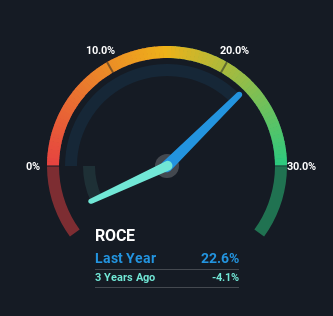- Singapore
- /
- Trade Distributors
- /
- SGX:BQF
Returns on Capital Paint A Bright Future For XMH Holdings (SGX:BQF)
Finding a business that has the potential to grow substantially is not easy, but it is possible if we look at a few key financial metrics. Firstly, we'll want to see a proven return on capital employed (ROCE) that is increasing, and secondly, an expanding base of capital employed. Put simply, these types of businesses are compounding machines, meaning they are continually reinvesting their earnings at ever-higher rates of return. Speaking of which, we noticed some great changes in XMH Holdings' (SGX:BQF) returns on capital, so let's have a look.
What Is Return On Capital Employed (ROCE)?
If you haven't worked with ROCE before, it measures the 'return' (pre-tax profit) a company generates from capital employed in its business. Analysts use this formula to calculate it for XMH Holdings:
Return on Capital Employed = Earnings Before Interest and Tax (EBIT) ÷ (Total Assets - Current Liabilities)
0.23 = S$18m ÷ (S$149m - S$70m) (Based on the trailing twelve months to October 2023).
So, XMH Holdings has an ROCE of 23%. That's a fantastic return and not only that, it outpaces the average of 8.6% earned by companies in a similar industry.
See our latest analysis for XMH Holdings

Historical performance is a great place to start when researching a stock so above you can see the gauge for XMH Holdings' ROCE against it's prior returns. If you're interested in investigating XMH Holdings' past further, check out this free graph of past earnings, revenue and cash flow.
So How Is XMH Holdings' ROCE Trending?
Like most people, we're pleased that XMH Holdings is now generating some pretax earnings. The company was generating losses five years ago, but now it's turned around, earning 23% which is no doubt a relief for some early shareholders. Additionally, the business is utilizing 25% less capital than it was five years ago, and taken at face value, that can mean the company needs less funds at work to get a return. XMH Holdings could be selling under-performing assets since the ROCE is improving.
On a side note, we noticed that the improvement in ROCE appears to be partly fueled by an increase in current liabilities. Effectively this means that suppliers or short-term creditors are now funding 47% of the business, which is more than it was five years ago. And with current liabilities at those levels, that's pretty high.
The Key Takeaway
In summary, it's great to see that XMH Holdings has been able to turn things around and earn higher returns on lower amounts of capital. And a remarkable 101% total return over the last five years tells us that investors are expecting more good things to come in the future. With that being said, we still think the promising fundamentals mean the company deserves some further due diligence.
If you'd like to know more about XMH Holdings, we've spotted 3 warning signs, and 1 of them doesn't sit too well with us.
XMH Holdings is not the only stock earning high returns. If you'd like to see more, check out our free list of companies earning high returns on equity with solid fundamentals.
New: AI Stock Screener & Alerts
Our new AI Stock Screener scans the market every day to uncover opportunities.
• Dividend Powerhouses (3%+ Yield)
• Undervalued Small Caps with Insider Buying
• High growth Tech and AI Companies
Or build your own from over 50 metrics.
Have feedback on this article? Concerned about the content? Get in touch with us directly. Alternatively, email editorial-team (at) simplywallst.com.
This article by Simply Wall St is general in nature. We provide commentary based on historical data and analyst forecasts only using an unbiased methodology and our articles are not intended to be financial advice. It does not constitute a recommendation to buy or sell any stock, and does not take account of your objectives, or your financial situation. We aim to bring you long-term focused analysis driven by fundamental data. Note that our analysis may not factor in the latest price-sensitive company announcements or qualitative material. Simply Wall St has no position in any stocks mentioned.
About SGX:BQF
XMH Holdings
An investment holding company, provides diesel engine, propulsion, and power generating solutions for customers in the marine and industrial sectors in Singapore, Indonesia, Malaysia, Vietnam, and internationally.
Flawless balance sheet with solid track record.
Market Insights
Community Narratives



